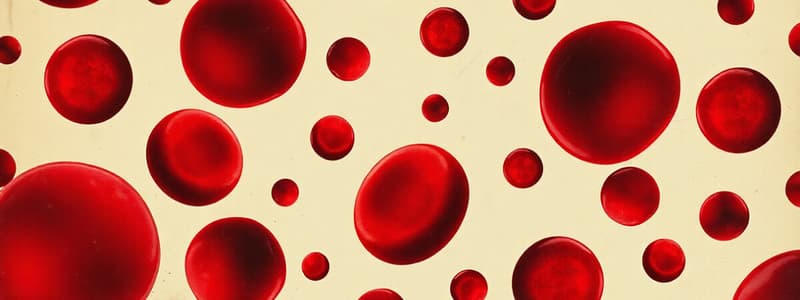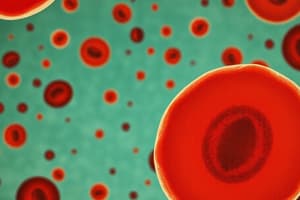Podcast
Questions and Answers
What is the typical hemoglobin concentration in red blood cells?
What is the typical hemoglobin concentration in red blood cells?
- 34 g per 100 mL (correct)
- 280 g per 1000 mL
- 280 g per 100 mL
- 34 g per 1000 mL
Which of the following statements accurately describes the relationship between hemoglobin and red blood cells?
Which of the following statements accurately describes the relationship between hemoglobin and red blood cells?
- Hemoglobin is a type of cell that transports oxygen in the blood.
- Each red blood cell contains approximately 100 molecules of hemoglobin.
- Each red blood cell contains approximately 280 million molecules of hemoglobin. (correct)
- Hemoglobin is a protein found only in white blood cells, not red blood cells.
What happens to deformed red blood cells (RBCs)?
What happens to deformed red blood cells (RBCs)?
- They are repaired by the body.
- They are expelled from the body through waste.
- They are destroyed and their components are recycled. (correct)
- They accumulate in the blood, leading to health problems.
What is the approximate volume of red blood cells in which 34 g of hemoglobin is typically found?
What is the approximate volume of red blood cells in which 34 g of hemoglobin is typically found?
If the hemoglobin concentration in a sample of blood is 17 g per 100 mL, what can be concluded about the sample?
If the hemoglobin concentration in a sample of blood is 17 g per 100 mL, what can be concluded about the sample?
Which cells play a crucial role in eliminating deformed red blood cells?
Which cells play a crucial role in eliminating deformed red blood cells?
Where does the breakdown of deformed red blood cells primarily take place?
Where does the breakdown of deformed red blood cells primarily take place?
Which of the following is NOT a factor that can influence the hemoglobin concentration in red blood cells?
Which of the following is NOT a factor that can influence the hemoglobin concentration in red blood cells?
What is the significance of the passageways in the reticular epithelial system?
What is the significance of the passageways in the reticular epithelial system?
What is the process of engulfing and destroying foreign bodies by cells called?
What is the process of engulfing and destroying foreign bodies by cells called?
What is the role of the nucleus in a proerythroblast?
What is the role of the nucleus in a proerythroblast?
Why is the nucleus of a proerythroblast large?
Why is the nucleus of a proerythroblast large?
What is erythropoiesis?
What is erythropoiesis?
What are platelets?
What are platelets?
Which of the following is NOT true about proerythroblasts?
Which of the following is NOT true about proerythroblasts?
What increases as a child grows older in relation to blood?
What increases as a child grows older in relation to blood?
Why is there a higher metabolic need for blood at the beginning of life?
Why is there a higher metabolic need for blood at the beginning of life?
How does the demand for blood change as one ages?
How does the demand for blood change as one ages?
What role does metabolic process play in blood requirements for a growing child?
What role does metabolic process play in blood requirements for a growing child?
Which statement accurately describes blood needs in early life stages?
Which statement accurately describes blood needs in early life stages?
What can sustained hypoxia lead to in terms of red blood cell count?
What can sustained hypoxia lead to in terms of red blood cell count?
Which condition is NOT associated with the development of polycythemia?
Which condition is NOT associated with the development of polycythemia?
What is a characteristic of compensatory polycythemia?
What is a characteristic of compensatory polycythemia?
Which of the following scenarios does NOT typically cause an increase in red blood cell mass?
Which of the following scenarios does NOT typically cause an increase in red blood cell mass?
What is the typical red blood cell count associated with polycythemia?
What is the typical red blood cell count associated with polycythemia?
What is the role of Erythropoietin in the body?
What is the role of Erythropoietin in the body?
What happens to the body's response when a specific area of bone marrow is damaged?
What happens to the body's response when a specific area of bone marrow is damaged?
According to the content, what is the primary function of red blood cells (RBCs)?
According to the content, what is the primary function of red blood cells (RBCs)?
What happens to the body's ability to produce red blood cells if the kidneys are damaged?
What happens to the body's ability to produce red blood cells if the kidneys are damaged?
What are the main types of cells that Erythropoietin stimulates the production of?
What are the main types of cells that Erythropoietin stimulates the production of?
Flashcards
Red blood cell deformation
Red blood cell deformation
When red blood cells become misshapen, they are broken down.
Macrophages
Macrophages
Special cells that clean up debris in the body, like broken down red blood cells.
Reticular epithelial system
Reticular epithelial system
A network of tissues and organs that help recycle components of old red blood cells.
Liver and spleen
Liver and spleen
Signup and view all the flashcards
Small passageways
Small passageways
Signup and view all the flashcards
Hemoglobin
Hemoglobin
Signup and view all the flashcards
Hematocrit
Hematocrit
Signup and view all the flashcards
Hemoglobin count per RBC
Hemoglobin count per RBC
Signup and view all the flashcards
Hemoglobin concentration
Hemoglobin concentration
Signup and view all the flashcards
Packed Cells
Packed Cells
Signup and view all the flashcards
Metabolism
Metabolism
Signup and view all the flashcards
Child growth
Child growth
Signup and view all the flashcards
Blood needs in childhood
Blood needs in childhood
Signup and view all the flashcards
Red blood cell breakdown
Red blood cell breakdown
Signup and view all the flashcards
What are platelets?
What are platelets?
Signup and view all the flashcards
What is erythropoiesis?
What is erythropoiesis?
Signup and view all the flashcards
Why is the nucleus of a proerythroblast large?
Why is the nucleus of a proerythroblast large?
Signup and view all the flashcards
What is a proerythroblast?
What is a proerythroblast?
Signup and view all the flashcards
How are red blood cells produced?
How are red blood cells produced?
Signup and view all the flashcards
Erythropoietin
Erythropoietin
Signup and view all the flashcards
Tissue Oxygen and Erythropoietin
Tissue Oxygen and Erythropoietin
Signup and view all the flashcards
Bone Marrow Damage Response
Bone Marrow Damage Response
Signup and view all the flashcards
Erythropoiesis
Erythropoiesis
Signup and view all the flashcards
Polycythemia
Polycythemia
Signup and view all the flashcards
Hypoxia
Hypoxia
Signup and view all the flashcards
Compensatory polycythemia
Compensatory polycythemia
Signup and view all the flashcards
Study Notes
Blood
- Red blood cells (RBCs) are biconcave discs, averaging 7.8 μm in diameter and 2.5 μm thickest, or 1 μm at the center.
- Average volume is 90-95 μm³.
- RBC membranes are flexible, allowing them to squeeze through narrow capillaries.
- RBCs have a lifespan of 120 days.
- Men have 5,200,000 ± 300,000 RBCs/mm³
- Women have 4,700,000 ± 300,000 RBCs/mm³.
- RBC production increases gradually in response to high altitude.
- 2 million new RBCs are produced per second.
- RBC indices include MCV (mean cell volume), MCH (mean cell hemoglobin), and MCHC (mean cell hemoglobin concentration), with normal ranges.
- RDW-CV (red cell distribution width coefficient of variation) ranges from 11.6-14.6%, with a standard deviation of 39-46fL.
- An increase in RDW indicates increased variability in cell volume.
Hemoglobin and Hematocrit
- Normal hemoglobin concentration is 34 g/100 mL of packed cells.
- Hemoglobin constitutes 33% of RBC weight.
- Normal hematocrit (packed cell volume) ranges from 40-45% for men and slightly lower for women.
- O2 carrying capacity is 1.34 mL/g of hemoglobin, or 19-20 mL O2/100 mL of blood.
- Hemoglobin transports 25% of CO2, binding at a different site than oxygen.
Erythropoiesis
- RBC formation begins in the yolk sac during early gestation.
- The liver and spleen are involved in erythropoiesis in the mid-trimester.
- Bone marrow becomes the primary site of erythropoiesis in the last month of gestation and throughout adulthood.
- Bone marrow contains stem cells that produce RBCs.
- Cellularity levels decrease with age despite the bone type present.
Hematopoiesis
- Pluripotent hematopoietic stem cells differentiate into committed stem cells and mature cells.
- Erythropoiesis is driven by growth inducers (e.g., interleukin-3) and differentiation inducers, with lineage-specific factors.
- RBC production is regulated by tissue oxygenation level, controlled by kidneys.
Regulation of RBC Production
- RBC mass is maintained within a relatively narrow range to ensure adequate oxygen-carrying capacity.
- Excessive blood viscosity is avoided to prevent increased heart load.
- Erythropoietin (EPO) is a growth factor for RBCs produced predominantly by the kidneys, and in lesser amounts by the liver.
- EPO production is regulated by tissue oxygenation.
- Reduced oxygen availability triggers EPO release.
Polycythemia
- Sustained hypoxia can lead to higher-than-normal red blood cell counts (over 5 million RBCs).
- Polycythemia can be caused by disease, high altitude, or chronic conditions.
- Erythropoietin production is increased in response to hypoxia.
Studying That Suits You
Use AI to generate personalized quizzes and flashcards to suit your learning preferences.
Related Documents
Description
This quiz explores the intricacies of blood, focusing on red blood cells (RBCs), their structure, production, and lifespan. It also covers hemoglobin concentration and hematocrit levels, providing insights into their normal ranges and significance. Test your knowledge on these vital components of the circulatory system.




